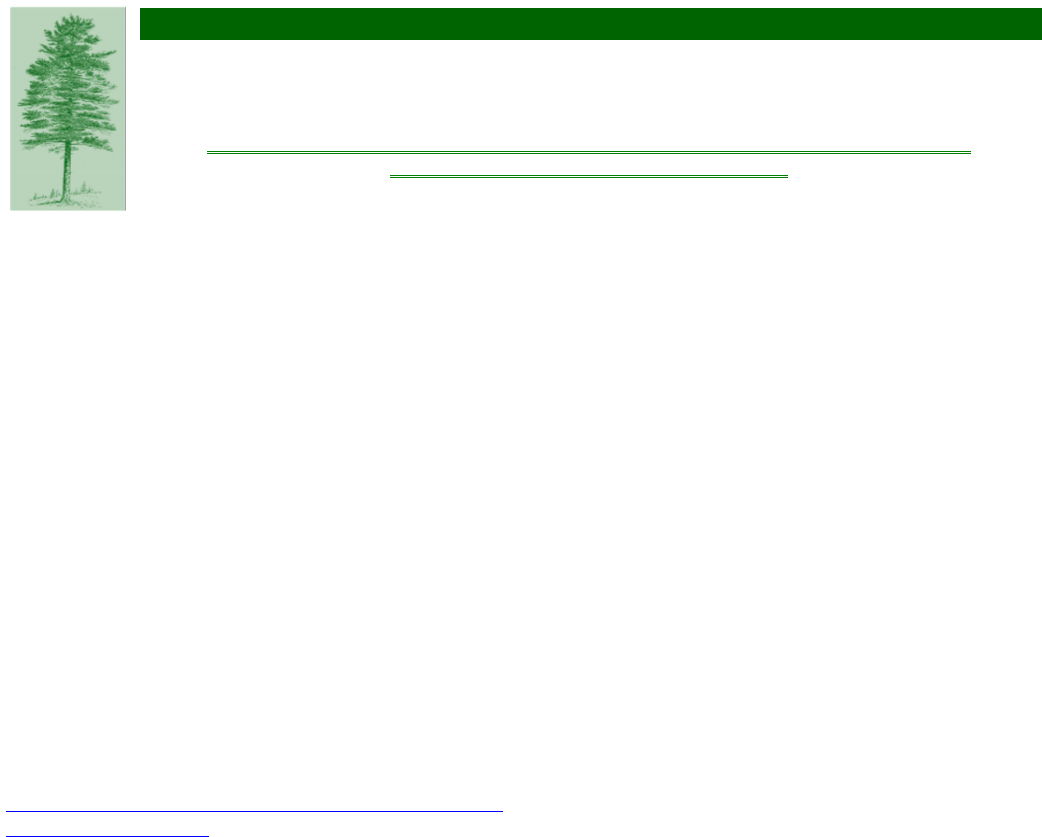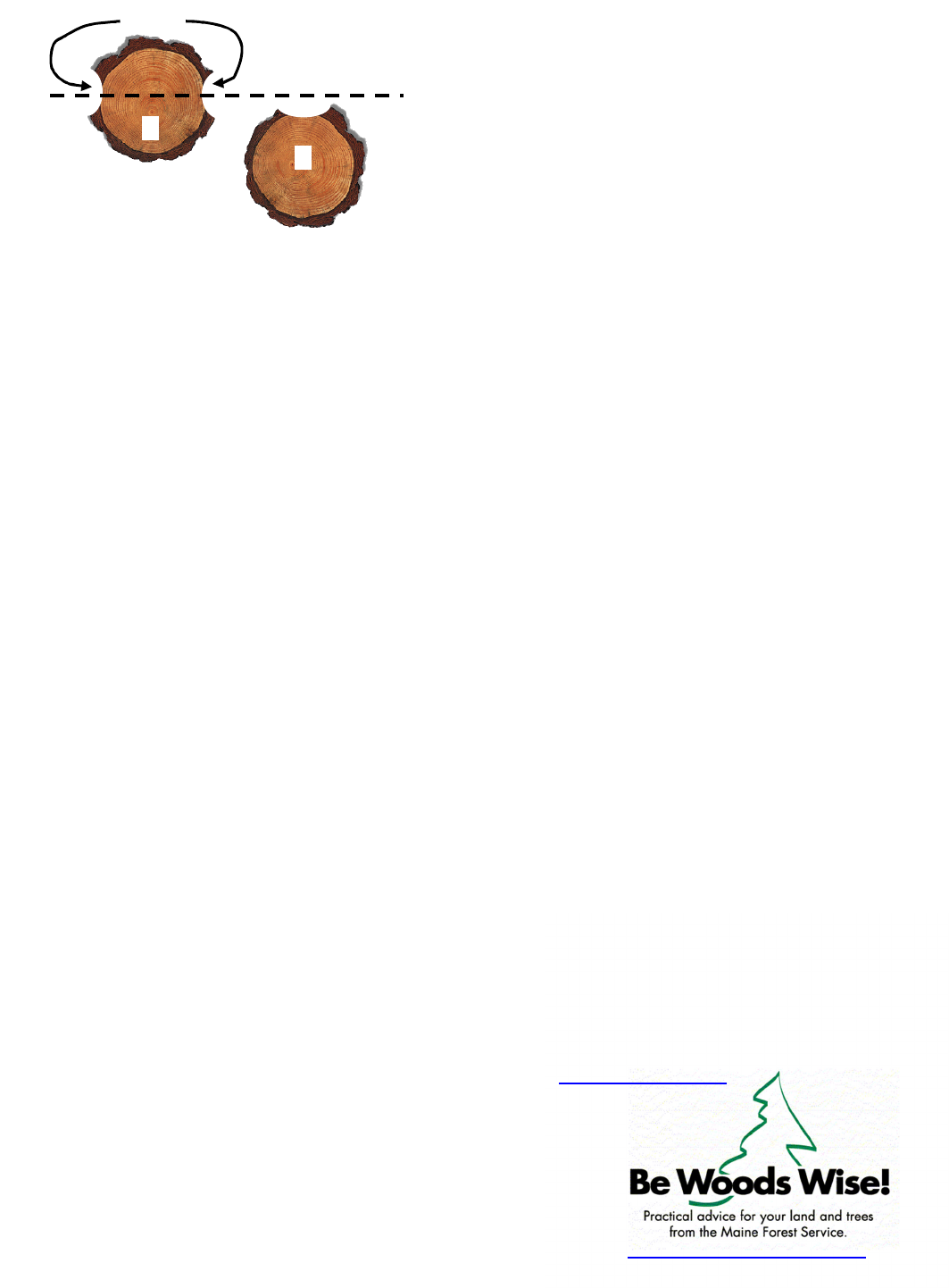
INFORMATION SHEET 4
REVISED: DECEMBER 2022
Boundary Line Information
Maine Forest Service, DEPARTMENT OF AGRICULTURE, CONSERVATION & FORESTRY
22 State House Station, Augusta, ME 04333
Practical advice for your land and trees from the Maine Forest Service
Robert Frost’s observation “good fences
make good neighbors” is as true today as when he
wrote it. As land and timber values increase, good
boundaries are even more important today than they
were in the past. The following information will help
landowners avoid boundary problems:
Establishing boundaries:
1. An “established property line” means a line
demarcated by monuments, signs, markings, pins,
reference points or other markers that denotes a
change in ownership between abutting properties.
These established property line markers must have
been placed upon mutual agreement of the abutting
landowners, based on historical physical evidence of a
preexisting boundary line or by a licensed professional
land surveyor.
Only a licensed surveyor can establish a property line
if there are no existing blazes or monuments.
Surveyors are licensed in the state of Maine under 32
M.R.S. §18201 et seq. A roster of land surveyors
licensed to practice in Maine is available online at:
https://www.pfr.maine.gov/ALMSOnline/ALMSQuery/
SearchIndividual.aspx
2. A landowner or licensed forester may maintain a
line where some monuments or blazes still exist. If you
cannot sight from one blaze to another, you should get
the line surveyed by a licensed surveyor. Previously
marked lines may be incorrect and will be relocated
after an accurate survey.
3. Monuments are relatively permanent features like
stone posts, iron bars, etc., that are established by a
surveyor. Tree blazes are not monuments, they are an
approximate location of where the line lies. A cap
listing the surveyor’s license number must be placed
on the lot’s corner posts.
4. Line trees are trees where the actual boundary
intersects any part of the tree, such that part of the
tree is on either side of the boundary (17 M.R.S.
§2511(1)(D). (See Tree A on the back of this sheet.)
Because they may be evidence of a line, blazed trees
on a property line serve as witness trees and should
not be cut. They generally have little timber value as
the blaze provides an avenue for bacteria and fungi to
invade the tree and cause rot. Line trees may also
have fencing tacked to them, which will cause them to
be rejected at a sawmill. Line trees may only be cut
with the permission of the abutting landowner (17
M.R.S. §2511(2)(B).
5. Before permanently marking a boundary by blazing
or painting, the line should be walked with the
adjoining landowner to ensure its location is mutually
agreeable. If there is disagreement about a line, it
should be surveyed. Landowners may agree to share
the costs; however, this should be agreed to or
otherwise determined before proceeding with the
survey.
Maintaining boundaries:
1. Boundaries should be painted with high grade,
durable paint. Colors such as red, yellow, orange or
blue are easily seen and visible for long distances.
Paints specifically formulated for marking boundaries
are available from forestry supply companies. Paint
trees only when the bark is warm and dry.
2. In blazing and painting trees along the boundary
line, the following rule is used:
A. If the boundary line passes through the middle of
a tree, blaze and paint on both sides of that tree
where the line passes through it (Tree A).
B. Where the line passes adjacent to the tree, blaze
and paint one point only, immediately adjacent to the
line (Tree B).
C. Be sure to paint generously so that lines can be
seen from either side. This will help prevent
accidental trespass.
3. Avoid blazing well-formed, large, or valuable trees as
blazing may degrade their value. Blazes should be over
six inches long and located about five feet above the
ground. Blaze often enough so that it is possible to see
the next blaze easily. When re-blazing a line, blaze
above or below the original blaze so that historical
evidence is not lost.

For more information, please contact:
Maine Forest Service
DEPARTMENT OF AGRICULTURE,
CONSERVATION & FORESTRY
22 State House Station
Augusta, ME 04333-0022
(207) 287-2791
forestinfo@maine.gov
www.maineforestservice.gov
4. Boundary lines should be brushed out for easy
traveling and visibility. Prune limbs to head height and
cut small trees along the line. Permission is required
to cut vegetation on another’s property. Check with the
adjoining landowner before proceeding.
5. Missing corners should only be placed by a surveyor
and be of permanent material, with the adjoining trees
(witnesses) marked for easy locating. Deteriorating
corner posts may be replaced with cedar or spruce
posts, as other species it will quickly decay. Iron pipe
is long lasting, easily transported, inexpensive, and
easily driven into the ground. Where available, pile
small stones around corner posts. Paint the stones
and the corner post. Leave existing old posts as
evidence.
6. High quality paint, properly applied, should last at
least ten years in the woods; axe blazes should last
longer. Lines should be checked and maintained
annually or periodically. Lines and corners should be
shown to family members so they can locate them in
the future.
Timber Harvesting and Boundaries:
Maine law protects adjoining landowners from timber
trespass and damages that occur during logging or
wood harvesting operations. If you are considering
harvesting timber, you should know and observe state
and local timber harvesting regulations near property
lines, trespass, and slash disposal laws.
1. Anyone who authorizes timber harvesting, or
harvests timber shall clearly mark with flagging or
other temporary and visible means any established
property lines within 200 feet of an area to be
harvested. Property lines must be marked prior to
commencing a harvest. Parcels less than five acres are
exempt. (17 M.R.S. §2511). Failure to clearly mark
property lines may also make the person who
authorized the cutting liable for forfeiture damages to
an abutter if a timber trespass occurs (17 M.R.S.
§2510(2).
2. Slash left from any cutting operations of forest
growth must be disposed of according to the following
regulations: (12 M.R.S. §9331-9336).
A. Along highways, slash must not be left in the right-
of-way or within 50 feet of a public highway.
B. Along railroads and utility lines (pipeline, electric,
telephone, telegraph, or cable) slash must be
removed from in the right-of-way or within 25 feet of
the nearer side of the right-of-way.
C. Slash that might constitute a fire hazard shall not
be allowed to remain on the ground within 25 feet
of the property line of land belonging to another.
No Trespassing Marking:
A landowner may mark their property with OSHA
Safety Purple paint to indicate that access is by
permission only. Paint should be a single stripe at
least one inch wide and eight inches long and
located between three and five feet off the ground
(17-A M.R.S. §402). Stripes should be no further
than 100 feet apart along the property line and at
vehicular entries. This should be in addition to a
properly marked and blazed boundary line.
Blazes
Boundary
B
A
